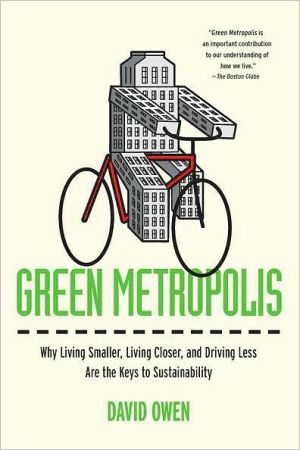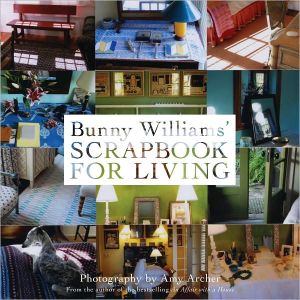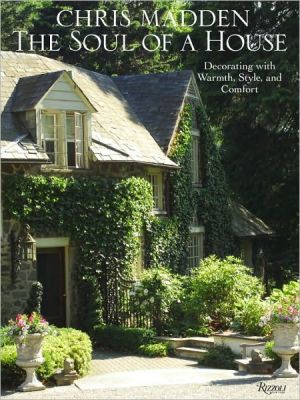Green Metropolis: Why Living Smaller, Living Closer, and Driving Less Are the Keys to Sustainability
Read David Owen's posts on the Penguin Blog.\ From the acclaimed New Yorker writer, a thought-provoking, innovative, and challenging new approach to protecting our environment.\ Most Americans think of cities as ecological nightmares-wastelands of concrete, garbage, diesel fumes and traffic jams-but residents of urban cores actually consume less oil, electricity, and water than hybrid- driving Vermonters do, and they have smaller carbon footprints. Essentially, they're forced to. In this...
Search in google:
In this remarkable challenge to conventional thinking about the environment, David Owen argues that the greenest community in the United States is not Portland, Oregon, or Snowmass, Colorado, but New York City.Most Americans think of crowded cities as ecological nightmares---as wastelands of concrete and garbage and diesel fumes and traffic jams. Yet residents of compact urban centers, David Owen shows, individually consume less oil, electricity, and water than other Americans. They live in smaller spaces, discard less trash, and, most important of all, spend far less time in automobiles. Residents of Manhattan---the most densely populated place in North America---rank first in public-transit use and last in per-capita greenhouse gas production, and they consume gasoline at a rate that the country as a whole hasn't matched since the mid-1920s, when the most widely owned car in the United States was the Ford Model T. They are also among the only people in the United States...The Washington Post - Jonathan YardleyThe deservedly respected journalist David Owen spent a lot of time in recent years patrolling the environmental beat, doing research for the excellent book we now have before us…Owen's style, here as in his 13 previous books, is cool, understated and witty; it does not appear to be in his nature to be alarmist. But this is a thoroughly alarming book, perhaps all the more so because Owen is so matter-of-fact: The facts alone are so discouraging that no rhetorical flourishes are necessary to underscore their urgency.
1 More Like Manhattan 12 Liquid Civilization 493 There and Back 1014 The Great Outdoors 1635 Embodied Efficiency 2036 The Shape of Things to Come 265Notes 325Index 347
\ Jonathan YardleyThe deservedly respected journalist David Owen spent a lot of time in recent years patrolling the environmental beat, doing research for the excellent book we now have before us…Owen's style, here as in his 13 previous books, is cool, understated and witty; it does not appear to be in his nature to be alarmist. But this is a thoroughly alarming book, perhaps all the more so because Owen is so matter-of-fact: The facts alone are so discouraging that no rhetorical flourishes are necessary to underscore their urgency.\ —The Washington Post\ \ \ \ \ Publishers WeeklyWhile the conventional wisdom condemns it as an environmental nightmare, Manhattan is by far the greenest place in America, argues this stimulating eco-urbanist manifesto. According to Owen (Sheetrock and Shellac), staff writer at the New Yorker, New York City is a model of sustainability: its extreme density and compactness-and horrifically congested traffic-encourage a carfree lifestyle centered on walking and public transit; its massive apartment buildings use the heat escaping from one dwelling to warm the ones adjoining it; as a result, he notes, New Yorkers' per capita greenhouse gas emissions are less than a third of the average American's. The author attacks the "powerful anti-urban bias of American environmentalists" like Michael Pollan and Amory Lovins, whose rurally situated, auto-dependent Rocky Mountain Institute he paints as an ecological disaster area. The environmental movement's disdain for cities and fetishization of open space, backyard compost heaps, locavorism and high-tech gadgetry like solar panels and triple-paned windows is, he warns, a formula for wasteful sprawl and green-washed consumerism. Owen's lucid, biting prose crackles with striking facts that yield paradigm-shifting insights. The result is a compelling analysis of the world's environmental predicament that upends orthodox opinion and points the way to practical solutions. (Sept.)\ Copyright © Reed Business Information, a division of Reed Elsevier Inc. All rights reserved.\ \ \ Library JournalNew Yorker writer Owen lays out a simple plan to address our environmental crisis—live smaller, live closer, and drive less. He presents a convincing argument that the antiurbanism of American environmental thought is flawed [Stewart Brand makes the same point in his Whole Earth Discipline, see above—Ed.]. The built-in efficiencies of urban life create and preserve open spaces, whereas suburban sprawl contributes to energy inefficiency and further environmental degradation. Just as Thomas L. Friedman in Hot, Flat, and Crowded discussed the role of oil in American life and our need to redefine America's vision, Owen asserts that every discussion about the environment is, in the end, about oil and that reducing environmental destruction means redefining our view of prosperity. He effectively connects the dots among oil, cars, public transportation, ethanol, rising food prices, and the role of plastic in modern life. VERDICT Owen's engaging, accessible book challenges the idea of green and urban living. Recommended for readers interested in urban planning or environmental issues. [See Prepub Alert, LJ 6/1/09.]—Robin K. Dillow, Oakton Community Coll., Des Plaines, IL\ \ \ \ \ Kirkus ReviewsWant to reduce your carbon footprint and save the planet? Move to Manhattan. New Yorker staff writer Owen (Sheetrock & Shellac: A Thinking Person's Guide to the Art and Science of Home Improvement, 2006, etc.) seeks earnestly to overturn the traditional wisdom that says the only way to show your love for Mother Earth is to move to the country, make candles and go locavore. "New York," he writes, "is the greenest community in the United States." This may seem counterintuitive, but consider: Most urbanites live in small spaces rather than the McMansions of suburbia, if only because they cannot afford anything larger, and most walk to the grocery store, take mass transit and get enough exercise to avoid becoming slugs (mere consumers, that is). Conversely, a back-to-the-lander may live virtuously, but taking a Volvo rather than Birkenstocks to the store undoes many good intentions. Owen assembles useful facts, some of them sure to be surprises even for the most learned of NYC boosters. Still, he recognizes that were it not for the accident of crowded island life, Manhattan and environs could just as easily be Los Angeles. "When cities are built on a ‘human' scale," he writes, "they virtually force the creation of vast suburbs, with miles of freeways, long commutes, traffic jams, and shopping malls." Occasionally the author inflates the significance of the facts to support his thesis. After all, it comes down to the hows as well as the wheres-a vegetarian living in the country, for instance, no matter how car-happy, will use fewer resources than a meat eater in the city. Owen works the city-versus-countryside theme into the ground-ruralites may feel a little picked-on-but the author does animportant service in pointing out that those who live in cities can be just as green as your garden-variety organic farmer-and even more so. He's no McPhee or Pollan, but Owen provides a dogged, contrarian argument that scores some good points.\ \








